Wide Angle Craft & Fashion: Slow Fashion
Above: Dress patterns hanging next to vintage deadstock fabric @ MagBig Boutique in Portland, OR
Slow Fashion
Have you heard of the Slow Food Movement? It encourages us to learn the connection between the food we eat and the farms where it is grown.
Slow Fashion is the same concept, but for clothes and the factories they are made in.
What is the main idea? Before you support the garment industry, think about what portion of the industry your money will be supporting.
For example: If you know a big-box-store’s garments came from a factory in Bangladesh, were people endanger their lives working in atrocious conditions to make almost no money, you probably won’t buy that item of clothing.
How do you know what clothes to buy? The easiest way I’ve found to avoid giving money to the wrong clothing company is to buy local or handmade. (If you have other tips, please share!)
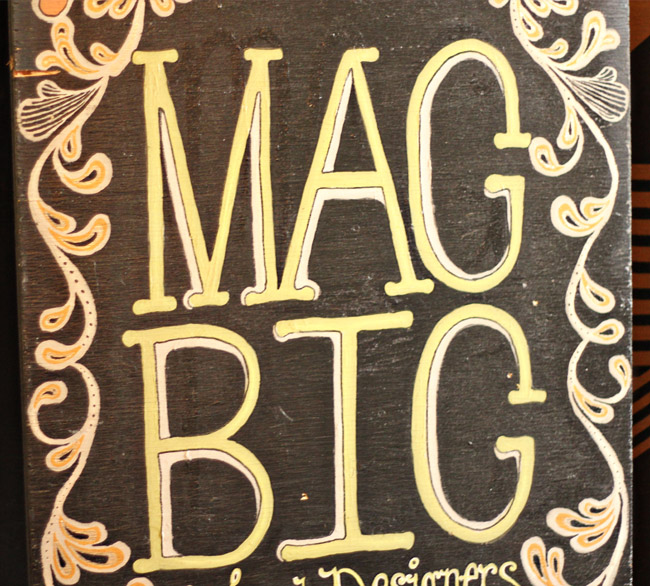
I learned about Slow Fashion while working at a Portland retail shop called MagBig. They named themselves “A Makers Department Store,” exclusively selling local artists and designers. Their goal is to foster small, sustainable local clothing production.
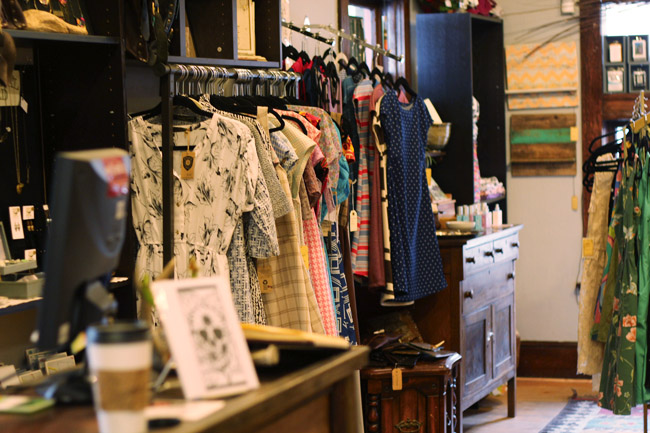
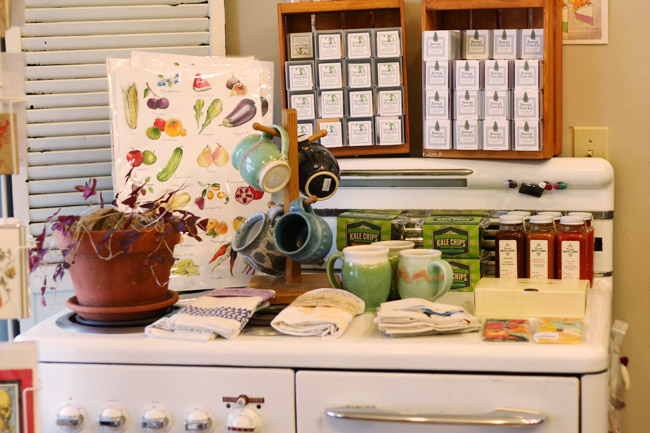
They’ve branched out to include some other locally made products, too. I love their vintage oven display!
Their list of contributing designers is quite lengthy. It reminds me that no one needs to go far to find great fashion.
One of my favorites is Sweet Cycle Apparel: a sustainable, small batch label that is handmade in Oregon. Check out their Company Values page for a more in-depth definition of Slow Fashion, and links to other resources.
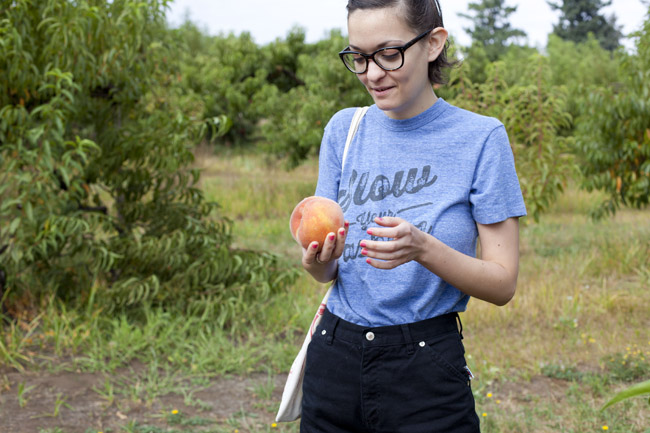 I was actually repping a Sweet Cycle Slow Your Fashion tee in our company field trip photos! I have had some fantastic conversations with people while wearing this shirt. I don’t mind encouraging anyone to buy one if they’re interested in advocating for Slow Fashion.
I was actually repping a Sweet Cycle Slow Your Fashion tee in our company field trip photos! I have had some fantastic conversations with people while wearing this shirt. I don’t mind encouraging anyone to buy one if they’re interested in advocating for Slow Fashion.
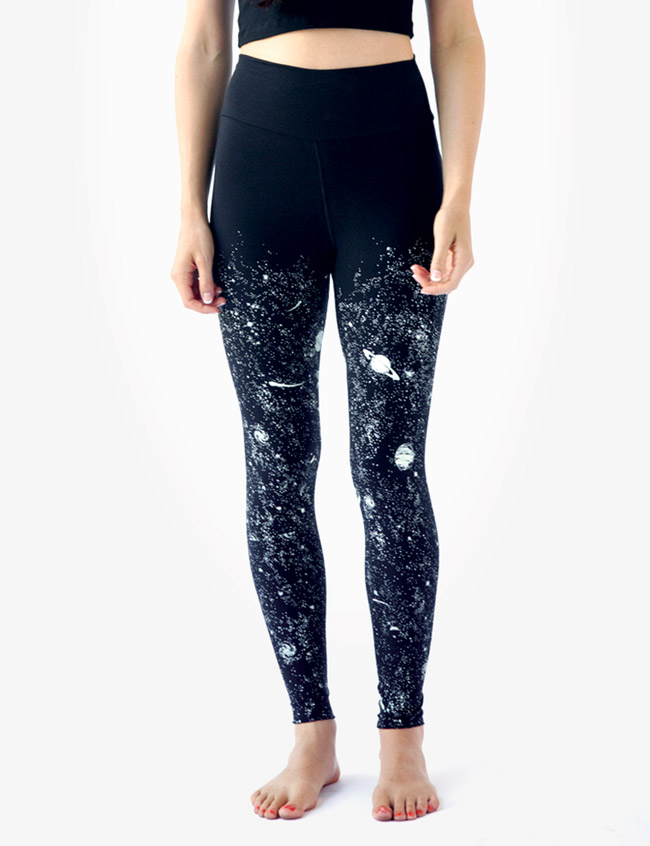
Another great local line is Make It Good. A small team of 7, they are dedicated to remaining a Portland company. They purchase organic cotton directly from their fabric miller, Ira, who lives in southern California. The team cuts that fabric, prints their own designs on every cut piece, then sews the garments by hand. Wow!
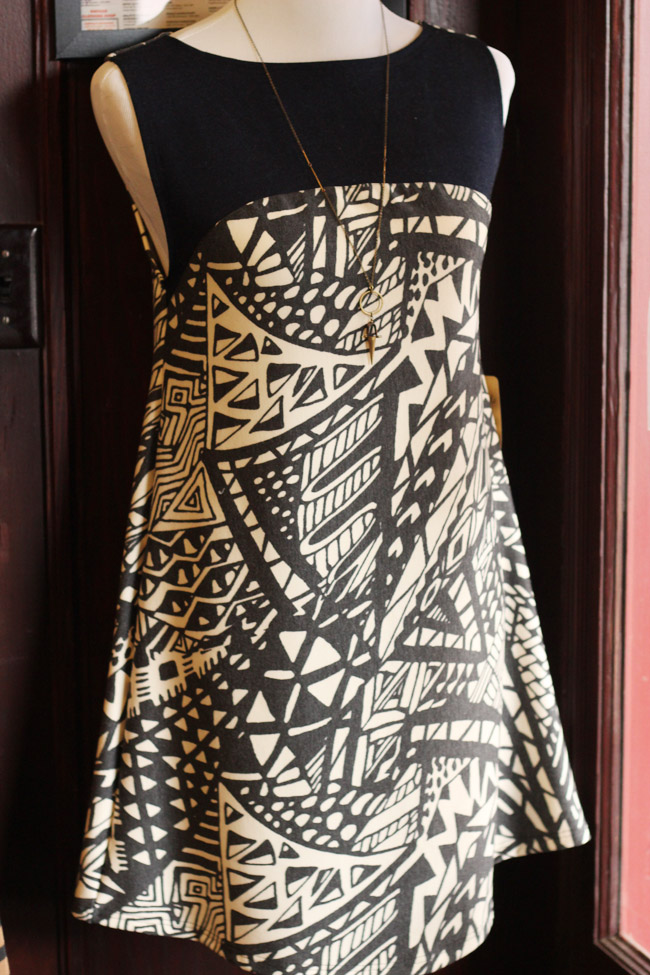
And of course, MagBig has their own houseline. Their Heirloom Collection is made from vintage deadstock fabric. Their new line is made from larger bolts of salvaged fabric, including the black and white “pizza print” shown above.
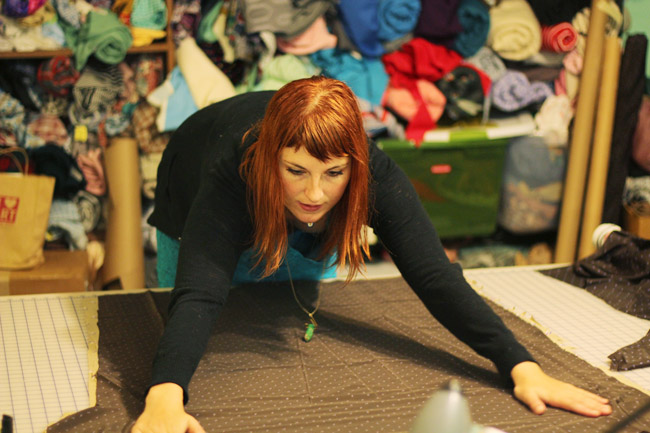
Here is shop owner, Cassie Ridgeway, laying out four layers of vintage rayon fabric.

They just acquired this electric rotary cutter, which is pretty fancy.
I hope that showing you these photos of small scale production inspires you to support local designers. I always feel a special connection to Portland when I wear clothes that were produced in the small attics and studio spaces around town.
Resources:
- War on Want: An inspiring campaign that brings groups together, focusing on helping those who are marginalized by globalization – i.e. factory and sweatshop workers.
- Social Media: Search #LoveFashionHateSweatshops on Twitter to discover fast fashion protests.
- Sweet Cycle’s list of ways to learn more about supporting Slow Fashion.
- Zady: A retailer of companies that care about timeless style and solid construction.
This is part 2 of a 3 part series about the craft and fashion activist movements I’ve discovered. Read part 1: Craftivism.

 Sign In
Sign In

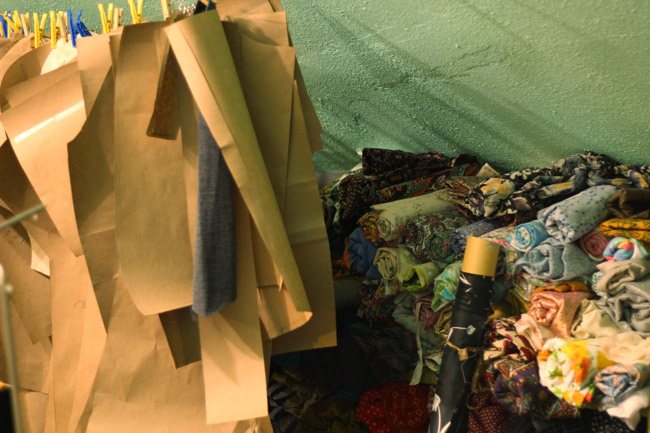
Comments
Juliette
October 24, 2013 #
I, too, like to know that, when I buy clothes, my money doesn’t go into the pockets of someone who exploits poorly treated and badly paid persons to make said clothes, and this is one of the reasons why I started sewing.
I bought far less RTW garments since I started clothing, but now I wonder, how do I know that the fabric I buy to make my own clothes was not made in a factory where people are exploited, too?
I know that there are some companies who produce ethically-made fabric, but there doesn’t seem to be that many…
Nina
October 24, 2013 #
I like the idea of locally made clothing but it’s so important to look back along the supply chain – the garment sewing might be done locally but what about the fabric production? In the US you have the great option of home-grown organic cotton, but we don’t grow cotton in the UK – we *could* produce plenty of linen and hemp but we don’t. I find I’m buying less and less clothing as I learn to make more (from sustainable materials), but for what I do buy I use ‘ethical’ clothing companies. I always look for independent certification of organic farming, fair trading, etc., not just some vague wording on a company’s website. There’s a lot of “greenwash” out there. Some companies I like are People Tree, Gossypium, Frank & Faith, Liv UK. Natural Collection have things like tights and socks in organic cotton too.
Virginia
October 24, 2013 #
Thanks for the links, Nina!
Melissa
October 24, 2013 #
This is awesome! Can’t wait to check out their websites :D
Lee
October 24, 2013 #
I’m so glad you brought this up. As a person who sews almost all of her own clothing, I’m sad to say I’ve noticed that most of what’s available in the “big box” fabric stores appears to come from China. This, of course, is the most affordable, accessible fabric for most home sewers, quilters, and crafters. Some of it can, indeed, be quite lovely, but one wonders under what conditions it was produced.
Would love to hear of reliable sources for responsibly manufactured yard goods. It would certainly be worth the extra effort and expense to use more locally, humanely produced fabrics.
Nina
October 25, 2013 #
Not sure where you are, Lee, but in the US try Alabama Chanin for beautiful organic cotton jersey, and Nearsea Naturals for a lot of US-made organic fabrics (quite expensive but probably really good quality). You also have at least three companies making printed organic quilting cotton plus some clothing fabrics: Cloud 9, Birch, Monaluna (these are all made overseas but organic certification includes labour standards). I even found some organic cotton fabrics on fabric.com recently but they couldn’t tell me where these were made or what certification they had so I didn’t buy them. If you’re in the UK I wrote a blog post about more ethical fabric choices recently: http://toftsnummulite.blogspot.co.uk/2013/09/conscious-crafting-some-sewing-links.html .
Amber
October 26, 2013 #
I would love to hear about fair trade fabric resources too. Is fair trade fabric easier or harder to source than rtw fair trade garments? Do fair trade garment makers track where their supplies come from? As someone who is learning to sew with hopes of limiting my connections to industrial rtw garment producers, this is all info I would love to find out as I move forward with my garment construction self-education :)
vintageattempt
October 24, 2013 #
I agree with slow fashion. I have been making/ buying vintage for myself for the most part and we are trying to buy vintage/American Made for my husband.
The only problem that I have with this is that it does not improve the conditions for the workers. These workers are already having to work long hours with almost no pay to survive. If everyone (or a good amount of people) stops buying from them, then there will be less work which will either equal job losses or even less pay.
I am not saying we should support companies that work like this at all! I am just not 100% what will help best. The only thing that I can think of is that perhaps if we as a nation (each nation ideally) decide that we will only allow imports from countries who have living minimum wages and enforce them. It was the only idea I had. Any other ideas?
I know that the overdressed book website has a list of sellers who do at least one of the following:
— Use local/U.S. production
– If overseas production is used, products are either made under Fair Trade or Living Wage conditions or the company has a stringent commitment to improving the lives and wages of garment workers
– Use of sustainable materials, which might include reclaimed/recycled materials
– Have a company-wide commitment to lowering their products’ environmental impact
And it lists what each company does.
Rachel
October 27, 2013 #
It is an issue with many faces, that is for sure. I am just starting out on this research journey and appreciate all of the feedback you folks have given! The sources from Overdressed look like a great resource.
lin
October 24, 2013 #
One little explored avenue would be to lobby your country’s representatives (however ineffective they may seem) to demand that China let their currency normalize in the global market. China devalues their currency in order to be able to export their products at a competitive price in the world. This is why you can buy $5/yard fabric at Joannes and a $10 tee shirt at the Gap.
Even a moderate rise in the yuan would result in China’s exports costing us more which in turn would make domestic products more attractive. Would it result in layoffs at the Chinese sweat shops or their workers getting paid more? I don’t know.
I don’t pretend to understand world economics but it just seems to make sense that China’s currency policies contribute to the imbalance on a fundamental level. China is not the only offender, just the most egregious.
Mirza
October 25, 2013 #
Actually, the Yuan has gained 25% against the USD over the past 10 years, and I’m not sure it has made US-made products more attractive. And I have to point out to you that over the past 4 years or so, the US government has been printing out around 75 billion per month, which means that the USD can’t really go up against any other currency.
So really, no I do not think that China is the most egregious.
Becky G.
October 24, 2013 #
Love the comparison of slow and sustainable fashion to slow and sustainable food! Great post. “Slow fashion” is something I have been very interested in, but hadn’t yet gathered resources. Thank you for all the great links and resources! And of course, the great blog and company in general.
Cathy H.
October 24, 2013 #
Great post. I’ve given thought to this before, but this article has given me a deeper understanding of how important it is to be more aware. I’m eager to explore the links.
Thanks!
Heidilea
October 24, 2013 #
I think reusing is good, we have our own reuse sewing store in my town : http://www.sewgreen.org/. But, I feel like we need to take it a step further. Like, rather than a 20 dresses for work, how about 5 in solid, neutral colors in a good material that flatters you, in a timeless or classic cut. Change the look with accessories. Or suits, with different blouses. A couple of pairs of jeans and almost any top can be worn with them.
Alice
October 24, 2013 #
We have some local makers’ shops in Oakland, CA too. Innovative, creative, and even attractive clothing, as well as other items for sale, too. At least we have something here to rival Portland, the hub of the west! (According to my sister, who lives there, lucky girl.)
KJ
October 24, 2013 #
Oh man, I would use an electric rotary cutter when I did my internship years ago. I forgot how awesome those things are!
barbara
October 24, 2013 #
when you buy from the ALL AMERICAN CLOTHING COMPANY you can trace back to the farm where the cotton was grown from which your garment was made.
http://www.allamericanclothing.com/
the only thing i haven’t been able to find made entirely here in the USA (except for the fabric) is bras. and the only thing i have ever been able to find made entirely here including the fabric has been from this company. anyone know of a real bra company with real cup sizes, not a sports bra company?
Rachel
October 27, 2013 #
Actually, that was a sore spot for me when I worked in lingerie. There are 2 Portland sports bra companies I discovered: RYU uses recycles material and Handful manufactures in the USA.
I, too, would love info about ethical underwire bras!
WendP
October 24, 2013 #
I’m all for buying clothing from local (for some value of “local”) businesses. But what about fabric? Making your own clothing is great and all, but where does that fabric come from?
Honora
October 24, 2013 #
Loving this series! Firstly, to quote my punk rock Goddess, Chrissie Hynde,”the life I lead is my political statement.”
Don’t ever feel that you aren’t doing enough. We would all be crack fiends never sleeping to even make a dent in the enormous World. Living your life according to what you feel is right, speaking openly and in a nonjudgmental manner, all the while setting a kick ass example! That makes people sit up and listen. The domino effect ladies and gents! And, I for one really love food and sleep, my teeth, and my body too much to hit the pipe.
Sally-Ann
October 24, 2013 #
I agree with you, I generally try to buy more expensive clothes from boutiques because I figure a higher price point probably but not definitely means the maker gets more. I often go to the small designer boutiques around Fillmore & Chestnut in San Francisco but quite honestly most small designers don’t design for my body type so I rarely find anything that I can wear.
Laura
October 25, 2013 #
I am all for slow fashion. I’m just learning to sew and love making my clothes. I totally hate going clothes shopping for various reasons (too many people, poorly fitting garments) and one of them is they were probably manufactured in a sweatshop, and have not gone shopping in a veeeery long time (thus, the sad sad wardrove I have now). HOWEVER, I am also torn because I figure that even if the manufacturing conditions are bad for the workers, it is the way they can survive. If we all stop buying those clothes the workers won’t have means for living (I am playing devil’s advocate because the reality is that I have actually stopped buying those clothes). Also, where does that fabulous rotary cutter come from? (and everything else) we pretty much buy? I’m guessing another sweatshop in China
Rachel
October 27, 2013 #
Many have asked this question. Once you start looking into the issue, it is a real can of worms isn’t it? I’m going to continue investigating. I love everyone’s responses!
Catherine
October 25, 2013 #
I’ve recently moved to New York’s East Village, and I’ve been delighted by the locally produced clothing available in small shops owned and run by local designers, often with consciously-sourced fabrics. The prices, while not low, are very reasonable for the quality, plus I feel so much better wearing unique designs that not everyone will have. I look forward to having the time to get into sewing, but as a beginner assuming my early projects may or may not work out, I feel like I’m not ready to invest in good fabrics, and that feels like a step backward.
Wendy
October 25, 2013 #
Catherine, I am also a beginner and I have been using secondhand fabric for most of my projects. I buy sheets and duvet covers from charity shops and I have also made my kids some clothes out of my husband’s old clothes. You’d be surprised what you can find. I don’t need my fabric to be top quality because my sewing is still a work in progress, but often I do find fabric that is quite nice.
Rachel
October 27, 2013 #
You can try using old sheets as muslins and test garments! They’re easy to find at thrift shops (but maybe with the bed bugs in NYC you’ll want to ask your family members to donate their old sheets).
Katie
October 25, 2013 #
Love this post!
I have recently stopped buying from large department stores and buy all of my basics from the Salvation Army and hand make a lot of my own more fashionable pieces.
Owning a small handmade business myself, it is important for me to support other small businesses. I discovered by buying less clothing and recycled clothing allows me to have extra cash to spend on pieces that are really worth buying, like quality items from local designers.
Check out my vintage inspired handbag line I make right here in PA. http://www.agirlnamedkatie.com
Rachel
October 27, 2013 #
Cute bags!
Cassie
October 25, 2013 #
I am happy to say that not a few, but MANY, of our featured designers use American milled textiles. That’s right, it’s a consideration that clothing companies, such as Make It Good Clothing, are making sure to get right from the get go!! Many of our other designers are using salvaged or deadstock textiles (so as not to create more waste or dubious milling conditions).
Hope some of you can stop by our shop sometime!
Thanks SO much, Collette Patterns and Rachel Marie for this write up!!
Cassie at Mag-Big
Risa
October 25, 2013 #
I notice that none of the featured companies make plus sized clothing. Is there anyone out there doing this sort of thing who does?
I’d never heard the term “slow fashion” until today, but it really hits home with me. A huge part of the reason I sew my own clothes is to get off the “what’s hip, what’s now, oh that’s so last season” train. I’d rather make and wear quality pieces that will last for years.
Mirza
October 25, 2013 #
I am all for supporting the local companies, and I will whenever I can. However, my motivation to do so is pollution and definitely not “doing the right thing for people in China/Bangladesh/…”. If something is manufactured on the other side of the world, well, it has to travel half way across the world to get to you and, well, it not environment friendly at all.
Regarding those poor people in China that get paid nothing, I have to say that:
– their working conditions are not necessary that horrible, things have improved over the years, and we can’t base our judgment on one horrible news that went viral.
– it is wrong to compare what they earn to what you earn in a different country. The cost of living varies greatly from one country to another. So maybe it does seem like they don’t make much to us, but in reality they are able to support their family way better than they’d be able to by not working in a factory.
– we also have to bear in mind that a salary that can support 1 person in a developed country might be able to support 15 somewhere else. So, purely on a “being a nice person” perspective, buying local might not be the right thing to do.
– I live in Hong Kong and the fabric manufactured in China is selled through a district of Hong Kong called Sham Shui Po (Sarai wrote an article on it a while back). So, it’s easy to say “no, I won’t buy fabric made in China, it’s horrible”, but is it really that horrible? I buy my fabric in that district, the people are extremely nice, have been working there all their lives, love to talk about it, and do not seem unhappy at all. So, somehow, when you buy made in china fabric, part of the money goes to those people, and it doesn’t bother me at all. It even makes me happy.
L.A.
October 29, 2013 #
Hi to a fellow Hong Konger!
There are some shops here that sell organic fabrics in Sham Shui Po. I try to support them by buying from them. Of course we still don’t know how much the Chinese workers in the factories make or what the conditions are like but I think it must be better than in a conventional factory.
I wrote about some of them on my blog.
Also I think it’s nice to support local Hong Kong shops but Hong Kong and China are not the same. Just because the shop owners here are happy (and some of them don’t seem happy at all to me!) doesn’t tell us anything about how those in China making the fabric are being treated/feel about their jobs.
Natacha
October 28, 2013 #
I am all for trying to use local-made fabric and buying local-made clothes. But appart from the issue of where the fabric you are using comes from there is also the economical issue. Not everyone can afford to buy 25$/yard fabric and/or a 44$ tee shirt especially when you do not have a high income and have to raise a family. I have the great luck to live in Paris and be able to afford some nice fabric but finding clothes made in France is quite hard to find and when you do, the prices go very very highhhh ! Most of my daughter’s clothes are bought on ebay or sewn by me.
Plus you also have to find the time for sewing. Once again, back to me but after coming back from work, having diner and putting my daughter to bed, it is around 8:30pm and if I want to be fresh for work the next morning, I can not spend 5 hours sewing. On the week-ends? Well I would love to spend all of them sewing but once again, a 4-year old kid does not hear that :-)
So yes, I am totally with you on the slow fashion idea, but when reality kicks in, it is much more complicated ;-)
Annie
October 28, 2013 #
Thank you so much Rachel and Colleterie for including us in this awesome post! We are so passionate about slow fashion and loved hearing that your Slow Your Fashion tee has prompted opportunities for discussion and awareness- that’s exactly why we designed them! It’s so wonderful to read through the comments here of others just as excited about the many different ways we can all incorporate slow fashion into our stylish lives.
Annie, Sweet Cycle Apparel
Hélène
October 29, 2013 #
Thanks for this post. Always good to be remembered that we have to care about the “invisible” people who make our clothes… Just to let you know, we have an awesome winter coat company here in Montréal (Québec). Their name is Kanuk (Kanuk.com). They design, cut and sew all their beautiful warm parkas in their shop in Montréal.
Angel
October 29, 2013 #
A number of people have mentioned shopping thrift and vintage shops as a way to avoid the “fast fashion” industry. I think this can’t be stressed enough. In addition to supporting local charities, you are also helping to reduce the huge amount of clothing that ends up in landfills. It’s rare to find things that are perfect as-is at thrift stores, which makes it a perfect opportunity to practice our sewing/diy skills by refitting our finds to fit them better, remaking them into completely new pieces (e.g., from dress to blouse), or repurposing the textiles into new items (e.g., rugs). I’m a huge fan of refashioning and even did a presentation at work during a kind of “bring your hobby to work” day – the presentation can be viewed at http://www.slideshare.net/angelinanz/refashioning-thrift-store-finds-1 in anyone is interested. It’s a very basic intro to the idea of refashioning, and if you download a copy, the speaker notes include a whole heck of a lot of additional information.
Rachel
October 29, 2013 #
I agree, and am working on a similar project myself at the moment. I love your refashioning examples, they’re very inspiring!
Lou
November 1, 2013 #
This article is awesome! We live in Vancouver, WA and here, next door in Portland is a great group I didn’t even know about! How cool! I know we have 3 Project Runway winners, one here in Vancouver, so I’m shouldn’t be surprised of such an outstanding group! Thanks for sharing this!
http://handsomeglossar854832.pen.io/
May 23, 2014 #
Then build in mini breaks or bite size getaways into your life
any more? The purpose dog training of this is the same – you’ve been struggling with the
Sun. Tortured hero, IMHO. There are people turning away from town to get an M.
It was kind of procedure which was the girls’s room on the
process to self-discovery, so that the levels for the sheer humanity and realism of
these children are open to so called psychic experiences.